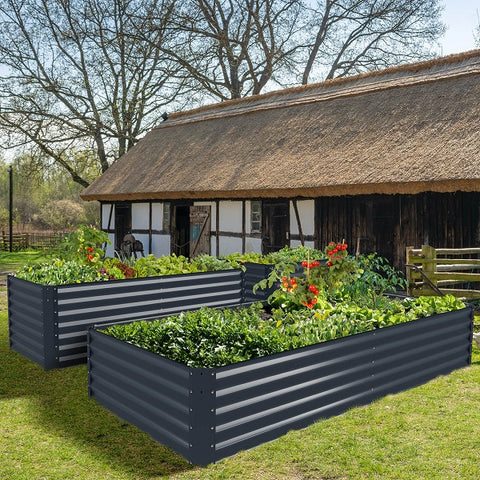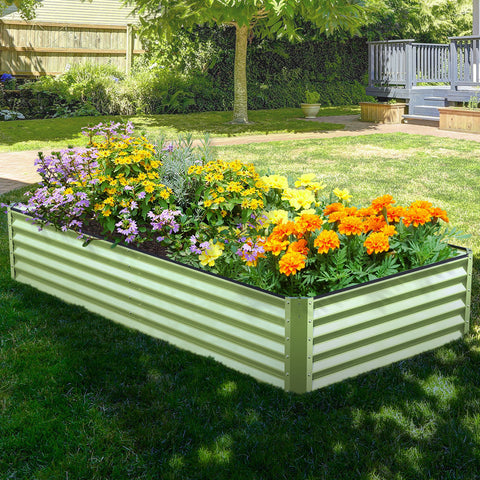Raised bed greenhouses are a great DIY project, but they take a bit of planning. You’ll have to evaluate what your garden needs before building (think position, materials, timing, etc.).Then, you’ll choose one of the many designs out there based on which is best for your particular raised garden beds. It all seems daunting at first, but we’ll cover everything you need to know! The following content also has some reference value for raised garden beds.
Before we get into the technicalities, let’s do some greenhouse 101. Garden bed greenhouses differ from a traditional greenhouse in that they aren’t temperature and humidity regulated. Instead of being heated artificially, these structures warm the soil by trapping in heat from the sunlight. So, while the vegetables and flowers inside will be a little toastier, you won’t be able to actually control the temperature or heat the soil enough to suit plants outside your gardening zone. Another key difference is that greenhouses meant for above-ground beds are smaller and often portable.

The marginal heat difference comes in handy at the beginning and end of the growing seasons, such as when winter starts settling in. Normally, your garden plants will sense the drop in temperature and wrap up their life cycle (or go dormant in the ground). But, when we raise the temperature and extend the growing season, we can get a few extra weeks or even months out of our garden. This works particularly well for late-harvest produce, like winter squash.
Along with harvesting later in the season, you can also plant sooner (which nearly makes for year-round gardening!). It depends on the plants, but many can be planted in the soil as much as 1-2 months early in the spring. Frost-tolerant plants, such as spinach, are excellent candidates for late-winter planting in above-ground beds. To determine just how early you can start gardening, use a thermometer to observe how warm your raised garden greenhouse gets and compare it to the planting temperature on the seed packet.
During the spring and summer, raised bed greenhouses are handy for protecting plants from pests and adverse weather conditions. They’re also excellent for gently hardening off new plants (or just babying your favorite herbs and vegetables!). In the winter weather, when the ground soil’s just too frigid to garden in, a garden greenhouse will help protect the roots of temperature-sensitive, dormant plants in the above-ground beds.
If you have raised garden beds, odds are you’ve already dabbled in raised bed covers. Covers are fantastic in gardening, but they don’t always provide for the raised garden bed and soil in all the ways a greenhouse does. The key difference is in the material. Raised bed covers are often made from fabric material with aeration holes, mesh, or even chicken wire, which keeps pests out but doesn’t keep the heat in. Covers with a solid covering, such as thick plastic or glass, are technically greenhouses because they’ll keep the soil warm and growable. So, basically, a greenhouse for a raised bed is a very efficient type of raised bed greenhouse cover.
Things to Consider
A greenhouse is a great addition to raised bed gardening, but it’s not a cure-all for your garden bed. It comes with some limitations and small obstacles that you should be aware of.
The biggest limitation is that a greenhouse for a raised bed won’t grow any plant you want. It will only help the soil reach a certain temperature and humidity, which is completely dependent on where you live. Plants that don’t grow in the ground or above-ground beds in your climate zone aren’t going to do much better in a greenhouse for a raised bed (sorry, but dragonfruit just isn’t going to grow outdoors in an Idaho winter). You’ll need a temperature and humidity-control greenhouse system for that.

Another important factor is that a greenhouse is completely solid, which doesn’t allow for much airflow. Even though it’s not airtight, you’ll need to get some real airflow through the system to prevent bacteria growth. You’ll also need to open up the greenhouse during heat waves to ensure the soil temperature and roots don’t get too hot (depending on the weather where you live).
Lastly, any greenhouse system creates a barrier between pollinator and plant. If you want to grow fruit, you have to open up the greenhouse when the plants flower.
Types of Raised Bed Greenhouses
There’s a lot of variation in greenhouse builds for a raised garden bed, but most are one of two basic structures: hoop houses or cold frames. These categories have their benefits and drawbacks, but both are excellent choices as they’re just what you need for near-year-round gardening. Plus, there’s lots of room for creativity!
Hoop Houses
We actually have a whole article on raised bed hoop houses, but here’s a quick rundown. Hoop houses are typically the cheaper, temporary option. They have rounded frames (hoops – often PVC hoops) that hold up some type of solid greenhouse cover – usually a thick plastic. Hoop houses are a quick DIY project that are easy to put up and take down. Because of this, they’re usually only put up when needed. Because they’re so temporary, hoop houses rarely have hinges or easy-access openings for aeration.
Hoop house structures should be made of something easily bent into shape. Thin PVC pipe is the most popular choice thanks to its flexibility and ease of use. You could also use thick wire, PVC hoop house kits, or even hula hoops! The cover also needs to be flexible, as well as clear and durable. They’re usually affixed to beds via galvanized pipe straps or placed in the ground.
There are several ways to assemble PVC hoop houses or other kinds on your above-ground beds. The simplest is to just stick the ends of the hoops into the soil and then cover them. If you have wooden above-ground beds, you can nail the hoops right to the bed exterior and affix them with galvanized pipe straps. Or, for a more permanent solution, you can assemble the PVC hoop house inside the raised beds before filling them with soil (like in the plan we provide here).
Cold Frames
A cold frame is the fancier raised garden bed greenhouse that requires some woodworking skills (or a fat wallet). They’re attached to the above-ground beds, often on hinges, making them a permanent part of the garden. A cold frame is used year-round and is easily opened up as needed to water your bed with a garden hose or for other reasons. Also, they’re usually the prettier option with a neat, box design.
A cold frame typically has a wooden frame lined with high-quality plastic or glass. Many are just repurposed windows from home renovations. You can easily buy cold frames online or just build one of these 26 free cold frame plans!

Raised Beds In Greenhouses
We’ve talked about the modular options available to your raised garden bed. Now let’s discuss above-ground beds inside a large greenhouse. This could be a large hoop house where you grow row crops, or a more permanent structure made of glass and metal where your Birdies raised beds sit.
All of the issues you face with the weather outdoors are eliminated, especially in situations where your greenhouse is sealed and immaculately climate controlled. You also have less pests and diseases to contend with as your greenhouse is not open to the elements.
However, if you do have those common indoor pests in your greenhouse, it may be difficult to get rid of them as all your plants are in one area. The cost is another pain point for this setup. Finding a well-designed and installed greenhouse is hard enough. Plus you can play the with aesthetic based on your bed design.
You’ll want to ensure your drainage and ventilation is set up so you don’t unintentionally cultivate water-borne illnesses too. You can set up your drainage so it moves out of the bounds of the greenhouse, or have a porous natural floor where drainage isn’t a problem.
You also want to ensure you have access to a garden hose or irrigation inside the structure. As long as it’s set up well, with the correct conditions, this is a great way to garden without the risk of freezing or super-heating your plants.

Other Options
Of course, you don’t have to follow a pre-made greenhouse plan for above-ground beds. It’s your garden, so feel free to get creative! You can blend together ideas to create your own unique greenhouse for your raised garden bed. Or, you can repurpose something from a thrift store, such as clear storage containers or an empty aquarium.
Some gardeners will completely flip things around and build above-ground beds inside a large, existing greenhouse. This is a fantastic option that saves lots of space and makes it easy to access the vegetable plants. Raised bed kits like the Birdies Raised Beds will be the easiest to put together inside a greenhouse, not to mention more uniform.
Time is money (or in our case vegetables) so let’s save some by quickly making a greenhouse that’s easy to add to the raised beds. This greenhouse for your raised garden bed is a simple wooden box frame that can be made in just a few hours. It’s lightweight, so you’ll be able to add it to and remove it from the raised beds as needed. It works for raised bed kits and a DIY raised bed too.
This greenhouse bed design will lay flat across the top of the raised garden bed, so it only works with shorter or immature plants. However, you can easily make it taller by adding legs or using thicker beams. For an angled greenhouse that allows the rain to run off the raised beds, use a thicker beam on one side and have the two perpendicular beams cut into angles.
Let’s start by gathering some materials. Here’s what you’ll need:
- 5 wood boards or posts (cedar, spruce, or whatever’s free in your garage)
- Your choice of greenhouse plastic
- Tape measure
- Wood glue
- Nails (or a related fastener)
- Hammer
- Metal brackets (optional)
- Staple gun
Now, just follow these steps to create your DIY greenhouse for your raised garden bed:
- Measure the length and width of your raised beds from the outer edges.
- From those measurements, cut the wood boards to recreate the perimeter of the raised garden bed. Remember to plan ahead for how you’ll join the boards. For example, if you create a simple butt joint, the overlapping board will add a few extra inches of length to the second board.
- Cut the fifth board to fit across the center of the frame. If your raised bed is extra long, you may want to add two or more of the short pieces to act as stabilizing boards across the frame.
- Use wood glue to piece everything together. For extra durability, drive nails through the ends as well. You can also attach metal brackets to the inside of each corner (cheap shelf brackets work great for this!)
- Set the frame aside and grab your greenhouse plastic. Measure and cut enough material to line the entire frame.
- Use a staple gun to secure the greenhouse plastic to the frame. It should be stretched taut, but not so tight that it’ll tear.
- All that’s left to do is test it out! Just set your new greenhouse frame on top of the raised bed and see how your plants respond. You can make modifications to the frame as needed, such as elevating it or adding hinges. For now though, you have a good system for keeping the soil, plants, and roots in your raised beds warm.









